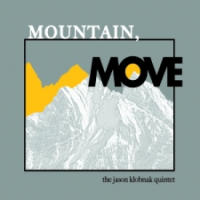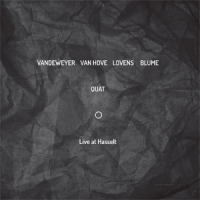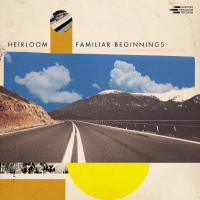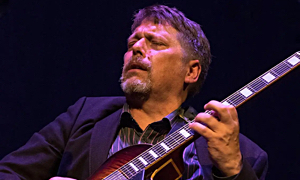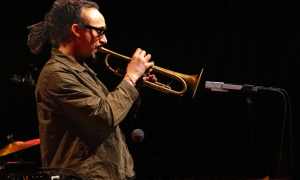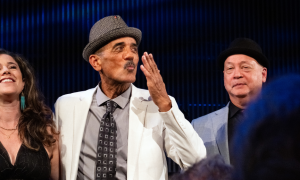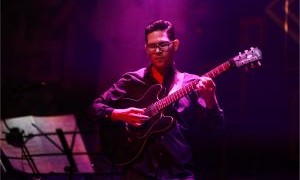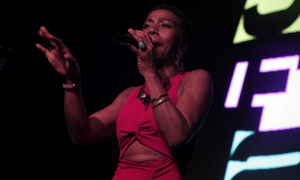Home » Jazz Articles » Live Review » Punkt Festival 2013
Punkt Festival 2013

Beginning with the simply repeated word, "grace," Ratkje began in spatial territory: gentle, at first, and beautifully melodic, with hints of Middle Eastern tonalities. While Endresen is the queen of acoustic voice experimentation, few singers integrate technology as Ratkje does. And she knows how to build a set, with near-episodic periods of ebb-and-flow, as she began to introduce a gently metallic percussive tone that faded in and out. Ratkje also possesses a rare ability to layer her voice in ways that make clear just how deep her understanding of harmony is. With a small microphone that she placed in her mouth to create vocal sounds not otherwise possible, her drone- based improv became increasingly more angular and rough-hewn
And if she scared that Irish attendee shitless, if anything, her set got scarier by the minute as she began to inject screeches, sibilant "sah's" and rapid chatter, all building to a cacophony of clearly controlled chaos—but controlled was the key, as she held a note for a seemingly impossible duration without the slightest hint of a quaver.
After building to a cathartic climax, she gradually brought things down again to come full circle to her gentle beginning, with simple words, processed chimes and a more mellifluous singing voice. Ratkje's clear understanding of dynamics and how to structure a set made this her best main stage appearance at Punkt, completely in the moment and with sheer and unerring instinct.
With Trømso-based electronics artist Per Martinsen alone for the remix—and, as became increasingly the MO this year, largely hidden behind an opaque curtain with only a silhouette of his body visible—he demonstrated the same kind of internal rhythm as Bang, a pulse that may or may not be revealed to the crowd...only time would tell, as the remix progressed.
In this case, there was, indeed, a pulse, but it was an odd one that combined some strange vocalizations from Ratkje—"Aooga," "Waaaah" and "Sah!" looped. But this only came after an opening with very little voice and a lot of gut-punching low frequencies. It was an odd remix, but one where, once again, the improvisational aspect of Tord Knudsen's visuals could not be overlooked. Knudsen responded with the same split- second instincts as any other musician, with Martinsen incorporating a wealth of discrete elements (how he kept track of them all was anybody's guess) into a sonic soup that closed the evening off on a high note.

Day Three, September 8: Eténèsh Wassié & Mathieu Sourisseau / Eivind Aarset "Dream Logic" / Nils Petter Molvær & Moritz von Oswald
With so much packed into so few days, try as one might it's almost impossible to catch everything going on. But mention must be made of Punkt's ongoing series of daytime seminars that, this year, included Bugge Wesseltoft, visual artist Hannah Bertram— responsible, amongst other things, for the compelling cover art to Jan Bang and Erik Honoré's Uncommon Deities (SamadhiSound, 2012)—Finnish architect Sami Rintala, Maja Ratkje, Estonian composer Helena Tulve and Norwegian video producer/soundscapist Kjell Bjørgeenen. That, along with two installations this year—one, at Kristiansand's Kunsthall, called Night gets five exits, a collaboration between Bjørgeenen and local poet/longtime Punkt collaborator Nils Christian Moe-Repstad, and the other at the Hotel Norge (where most artists, media and guests stay) that was meant to be a place where folks could go and unwind/destress—demonstrated the festival's commitment beyond music performance (and accompanying visuals) into all aspects of creativity.
Then there was K-35, the place where musicians, media and guests of the festival went, during the day and late into the evening, to eat, drink, relax and interact. Punkt has always maintained a remarkable transparency that dissolves the walls between artists and media and artists and fans. With only a couple of exceptions, if you want to meet your favorite artist, he or she is often as close as the seat beside you at breakfast, at Kick, or at K-35, and it's this creation of an open, friendly atmosphere that has contributed to some of Punkt's best ideas; after all, when a couple of artists who've never met each other before sit down for a drink at K-35, who knows what might come of it?

Meanwhile, back at Kick for the last night of Punkt 2013, it was a combination of old friends, new friends and old friends in new constellations. The evening opened up with festival first-timers, Ethopian singer Eténèsh Wassié and French bassist Mathiew Sourisseau. Bass and vocals are not a new idea—in the jazz world, for example legendary singer Sheila Jordan has shared a longstanding duo with bassist Harvie S. But with Sourisseau playing an acoustic bass guitar fed through a series of processors, the possibilities became much greater for a duo that, at first, seemed to have the audience a little puzzled but, as the show went on, captured it entirely, the closing number meeting with a level of applause far louder than what the number of people in Kick should have realistically been able to muster.
And it was a well-deserved ovation. The duo was originally invited to perform at a Punkt evening last year in Paris, at France's Banlieues Blaues festival. Elements of Africa/Nigerian tradition met, with Sourisseau's strummed, low chords, something akin to Tunisian oudist Anouar Brahem's music.
The show gradually became more dramatic, bolstered by some remarkable visuals; a row of planetoid-looking ovals were scattered in ways that looked three-dimensional; as Sourisseau began to play with greater intensity, adding distortion to the mix, Tord Knudsen's waves of light—almost like a cage—began to surround them—a remarkable effect.
At one point a heavily reverbed and prepared bass created a drone, with overtones and harmonic feedback, as Sourisseau played his instrument with a handheld device— possibly a small rotary sander. The piece became increasingly extreme, with sudden peaks, stops and starts; at one point, Sourisseau literally flipped his bass on its head and rubbing the top of it along the stage floor. Becoming more extreme still, everything suddenly stopped and, with all the noisy sonics gone, the piece concluded with nothing but spare chords and Wassié's whispery voice. With Sourisseau's softly tremelo'd bass guitar and Wassié's expressive voice, there were times when the set loosely resembled Dutch cellist Ernst Reijseger's trio with Africa singer/percussionist Mola Sylla and fellow Dutch pianist Harmen Fraanje, heard recently on Down Deep (Winter&Winter, 2013)
There were also times when Wassié's plaintive voice made the meaning of her words if not unimportant, then at least unessential to feeling what the music was about. She seemed, at times, to be more speaking than singing, but it all made for a powerful performance that closed with an a cappella vocal intro that demonstrated Wassié's full (and broad) range, and her control over dynamics. As Sourisseau joined in, driving the number with a powerfully propulsive groove, the audience spontaneously began to clap along; proof that the audience may have been uncertain at the beginning of their show, but was completely won over by its conclusion.

With music of such Afro-centric origins, it was no surprise that the festival chose Audun Kleive to participate in the live remix with Jan Bang. The drummer/percussionist is one of Norway's most well-known drummers, having played with everyone from guitar hero Terje Rypdal to pianist/composer Jon Balke, in addition to releasing his own records, many under the moniker of Generator X. A rare player who can do more with a single cymbal—as he proved, last year, at the 60th birthday celebration for Sidsel Endresen at Oslo's Nasjonal Jazzscene Victoria—than many drummers can do with a full kit, he's also a member of the remarkable Jøkleba trio, with Balke and trumpeter/singer Per Jorgensen that impressed those brave enough to participate in the Ekstremjazz afternoon at this year's Vossa Jazz Festival, where Kleive used nothing but a Roland Wave Drum.
For the Punkt live remix, while Kleive wasn't directly visible with Bang, as the opaque curtain largely hid them from the audience, Knudsen's camera captured and processed his image—often, just his hands—to create another visual presentation that suggested Punkt's old laboratory ambience may be gone, but what's replaced it was no less captivating. At times, the remix drew on Wassié and Sourisseau's music so directly that it felt like Kleive was a drummer who would have worked very well with them in real time, even though their music didn't really need it. Kleive's stylistic reach seems endless, and his ability to work with Bang to create a live remix with its own narrative flow resulted in a performance that stood both alongside its source music and on its own as a separate entity. With Punkt's tenth anniversary now on the horizon, and with only one album released—Live Remixes Vol 1 (Jazzland), featuring Sidsel Endresen and trumpeter Jon Hassell (a clear touchstone for much of the music emerging from the Punkt axis today)—already five years old, it's time to release some more examples of Punkt's innovations to a larger international demographic.
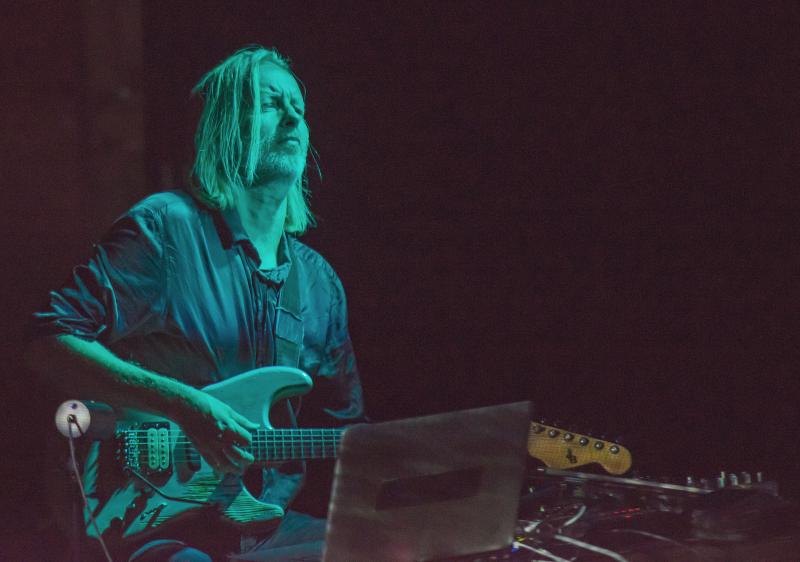
When guitarist Eivind Aarset released Dream Logic (2012)—his first release as a leader for ECM Records, after a string of superb albums on Jazzland—it came as something of a surprise, even to the most ardent fans of this guitar anti-hero. A near-solo recording, with layers of guitars, the only collaborator was Jan Bang, and while this unexpectedly dark, quiet and gentle recording has been performed live in duo with Bang, it's largely been toured with Aarset's Sonic Codex group—bassist Audun Erlien and drummers/percussionists Rune Arnsen and Erland Dahlen—bringing a completely different perspective to some of Aarset's deepest writing of his career. As one more special Punkt performance, Aarset was able to bring Bang together with Sonic Codex, resulting in a show that demonstrated the guitarist's increasing musical depth and breadth.
Opening in dark ethereal terrain, with Aarset's snakelike eBowed guitar and Bang creating broad brushstroke washes of sound, Dream Logic was taken much further, and to far different places. Dark, early '70s Miles Davis-informed grooves blended with singing saws (Dahlen), tuned metal (Arnesen) and bowed guitar to take the music into territory at once whisper-delicate and more aggressively free than Aarset achieved with the studio recording. That only two years ago Sonic Codex was more akin to progressive rock—as evidenced by its incendiary show at the 2011 Montreal Jazz Festival—than the indigo moods of Dream Logic only supported Aarset's unfailing confidence in the potential of this group, Erlien even picking up a guitar at one point, to add a tremelo'd chordal foundation to one of Aarset's pieces.
With Norway possessing a number of outstanding drummers that's disproportionate to its small population of five million, it also does twin-drummer groups like few others, Dahlen and Arnesen (who goes back to Aarset's earlier Light Extracts group) seemed joined at the hip; beyond the additional textures they added with a plethora of hand percussion and Dahlen's saw, when they settled into a groove together on kits, it seemed like a single body with four arms and four legs, rather than two separate people. Erlien's bass play was some of his most inspired in recent memory; clearly Aarset's music has inspired everyone in the group to think considerably more outside the box. Meanwhile, Aarset was his characteristically patient self, allowing the music to unfold slowly, and doing very little to draw attention to himself, except that the sonic landscapes he created—and, in this case, in some lovely push and pull with Bang—were impossible to deny.
Unlike most of Aarset's live performances, this show was not completely continuous; still, while there were breaks between pieces, with the exception of introducing the band at the end of the set, there were no additional introductions by the characteristically quiet, reticent guitarist. But Aarset never needed to speak; his music has always said everything, but with Dream Logic representing a significant step forward, at his 2013 Punkt performance his music spoke even greater volumes.

With the dream team of Arve Henriksen, Jan Bang and Erik Honoré remixing Aarset's performance, the benefit of being able to jump right into the live remix with almost no pause was proven, as Henriksen took the two notes that Aarset's group made its thundering, dramatic conclusion, and turned them into the starting point for a remix that also demonstrated Punkt's ever-present philosophy: that a live remix is no shorter than it needs to be, but no longer, either.
 With Bang and Honoré taking Henriksen's two notes and slowly moving into ambient. territory, the trio ultimately almost moved in parallel to Aarset's show as it began to turn towards freer and more extreme territory. That Henriksen is a founding member of Norwegian noise improv group Supersilent means that such extremes are far from foreign to him, but with his own solo work, leading right up to Places of Worship, predicated far more on beauty and lyricism, it was great to hear him cut loose a bit.
With Bang and Honoré taking Henriksen's two notes and slowly moving into ambient. territory, the trio ultimately almost moved in parallel to Aarset's show as it began to turn towards freer and more extreme territory. That Henriksen is a founding member of Norwegian noise improv group Supersilent means that such extremes are far from foreign to him, but with his own solo work, leading right up to Places of Worship, predicated far more on beauty and lyricism, it was great to hear him cut loose a bit. As Bang treated Henriksen's playing and Honoré introduced Dahlen's singing saw, Henriksen orbited around its otherworldly thematic fragments, as the trio brought the remix to a close: short, but oh, so sweet.
For Punkt's final performance of 2013, another member of the family premiered a new project. Nils Petter Molvær has appeared many times at Punkt, including the final performance of his decade-old group at the festival in 2007, which signaled a significant change in direction for the trumpeter who literally created a musical paradigm shift in 1997 when he released his first of two albums on ECM, Khmer. While it is still uncertain where he will be going after the dissolution of his trio with Erland Dahlen and Stian Westerhus, documented solely on 2011's Baboon Moon (Sula), the premier of his collaboration with techno/dub legend Moritz von Oswald suggested both change for the intrepid Molvær and a partial return to the more beat-heavy music of his mid-naughties albums er (Sula, 2005) and Streamer: Live (Sula, 2004).
For one thing, Molvær has been playing a lot more unprocessed horn these days, and it suits him well. His distinctive tone remains, but was, at times, a little more tart than the breathy tone he has so often adopted. That's not to suggest he wasn't still processing his horn; he also had some new approaches, including using a pitch shifter to create a parallel harmony, but then using a foot pedal to bring the two notes closer together— sometimes so close as to create rapid beats of their own.
Along with von Moritz, nephew Laurens von Moritz fleshed the project out to a trio, and between Molvær's horn and the two von Oswalds' broad-spectrum electronics, the set ran the gamut from ethereal, ambient atmospherics to downright danceable grooves. While Punkt had set Kick up for a largely seated audience, this was music that might have been even better had it been in a standing room environment or, better yet, a dance club. Molvær's intrinsic melodism was the connecting thread throughout this continuous set, culled from the duo's debut recording, 1/1 (EmArcy, 2013), due out October 4. But, once again, Punkt got the lead on a project that will not be performed live again until the end of September, just a few days before the album hits the streets.
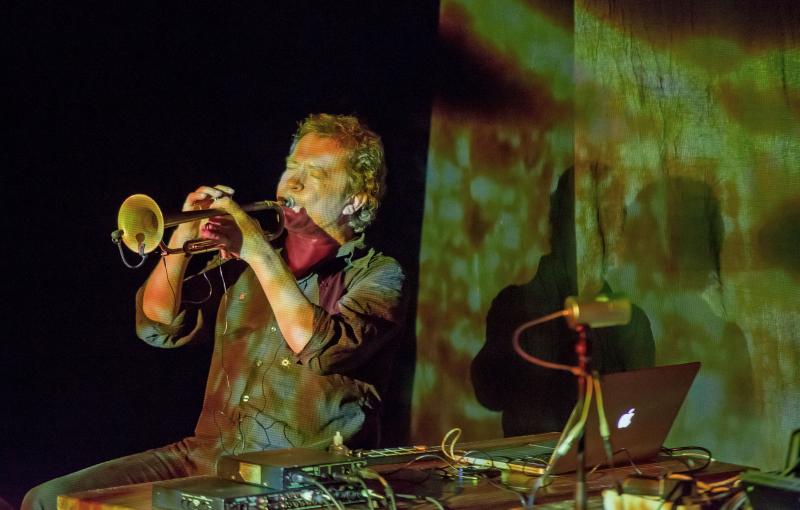
With Molvær's horn continuing to push the envelope, the release of 1/1 will represent something of a sidestep for the trumpeter, but one that should garner him even more international acclaim than he as already achieved. As for his own projects? He'll be hitting King's Place in London in November, for a series called Scene Norway 2, curated by Fiona Talkington and featuring a solo performance along with collaborations including drummer Martin France's Spin Marvel and a live soundtrack to silent film, together with Jan Bang.
Which, sadly, brought Punkt to its final remix and final performance, another solo live remix by Vladislav Delay. There's no doubt that Delay is a master remixer and legitimate new member of the Punkt family, but one of the cornerstones of the festival's live remixes has been their integration with live musicians. Delay is tremendously creative, and took von Moritz and Molvær's set to more extreme, industrial places that they might never have imagined, but as Delay's second remix of the year, it would have been interesting to see just what he would have done in collaboration with others. No doubt he will be back in future years; hopefully he'll consider the possibility of working with others.
Wrap-Up
And so, with a new home and a very intentional refocus on the cornerstones that have made Punkt the internationally renowned festival it is, it very much looks as if Punkt is back, after an unexpected sidestep in 2012. While the program returned to a more Scandic-heavy roster, reminiscent of its earlier years, there have been so many lessons learned over the past several years that Bang, Honoré and the whole Punkt team have still managed to keep it moving forward.
From the morning after through to an evening in Oslo, nearly a week later, where Bang, Honoré, Endresen and other Punkt regulars were taking in Stian Westerhus' new group, Pale Horses, there's been continued discussion about what worked this year, what didn't and how the team can prepare for its tenth anniversary in 2014. There are already some intriguing plans in the works, but what is certain is that Punkt will return to Kick, and while some retrospective looks at its first ten years will be expected, the other thing that Punkt fans can take to the bank is that from a musical perspective, Punkt will continue to strive towards new frontiers, new constellations and new collaborators from around the world.

If Punkt 2013 was one of its best years ever, watch out for 2014: the best is most certainly yet to come.
Photo Credit
All Photos: John Kelman
Tags
Jan Bang
Live Reviews
John Kelman
Norway
Oslo
punkt festival
Brian Eno
Erik Honore
Arve Henriksen
David Sylvian
Christian Fennesz
Nils Petter Moilvær
Eivind Aarset
Bugge Wesseltoft
Maja Ratkje
Tigran Hamasyan
Sidsel Endresen
Mathias Eick
Huntsville
Ivar Grydeland
Audun Kleive
Anders Jormin
Mats Gustafsson
Jaga Jazzist
Iro Haarla
Clifford Brown
Kenny Wheeler
Chick Corea
brad mehldau
Herbie Hancock
Stian Westerhus
Ingar Zach
Supersilent
Keith Jarrett
Arild Andersen
Jimi Hendrix
Cecil Taylor
Maja S.K. Ratkje
Spunk
john zorn
Frode Haltli
Sheila Jordan
Harvie S
Anouar Brahem
Ernst Reijseger
Harmen Fraanje
Terje Rypdal
Jon Balke
Per Jørgensen
Jon Hassell
Audun Erlien
Erland Dahlen
Miles Davis
Martin France
PREVIOUS / NEXT
Support All About Jazz
 All About Jazz has been a pillar of jazz since 1995, championing it as an art form and, more importantly, supporting the musicians who make it. Our enduring commitment has made "AAJ" one of the most culturally important websites of its kind, read by hundreds of thousands of fans, musicians and industry figures every month.
All About Jazz has been a pillar of jazz since 1995, championing it as an art form and, more importantly, supporting the musicians who make it. Our enduring commitment has made "AAJ" one of the most culturally important websites of its kind, read by hundreds of thousands of fans, musicians and industry figures every month.



